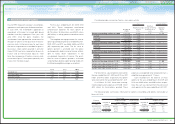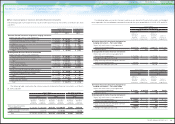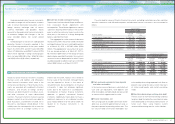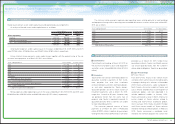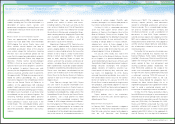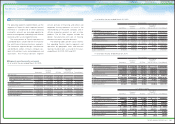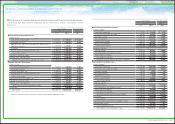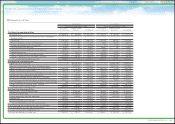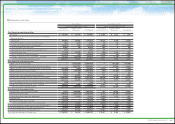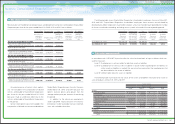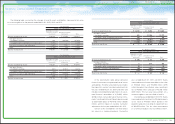Toyota 2011 Annual Report Download - page 99
Download and view the complete annual report
Please find page 99 of the 2011 Toyota annual report below. You can navigate through the pages in the report by either clicking on the pages listed below, or by using the keyword search tool below to find specific information within the annual report.
0822
Financial Section and
Investor Information
Business and
Performance Review
Special FeatureMessage/Vision
Management and
Corporate Information
Notes to Consolidated Financial Statements
antilock braking system (ABS) in certain vehicles
models including the Prius. Set forth below is a
description of various claims, lawsuits and
government investigations involving Toyota in the
United States relating to these recalls and other
safety measures.
There are approximately 200 putative class
actions that have been filed since November
2009 alleging that certain Toyota, Lexus and
Scion vehicles contain defects that lead to
unintended acceleration. Many of the putative
class actions allege that malfunctions involving
the floor mats and accelerator pedals do not
cover the full scope of possible defects related to
unintended acceleration. Rather, they allege that
Electronic Throttle Control System-intelligent
(ETCS-i) is the true cause and that Toyota has
failed to inform consumers despite its awareness
of the problem. In general, these cases seek
recovery for the alleged diminution in value of the
vehicles, injunctive and other relief. In April 2010,
the approximately 190 federal cases were consol-
idated for pretrial proceedings into a single
multi-district litigation in the United States District
Court for the Central District of California. In
addition, of the approximately 325 individual
product liability personal injury cases relating to
unintended acceleration pending against Toyota,
the federal cases have been or are likely to be
consolidated into the multi-district litigation. The
remaining individual product liability personal
injury cases relating to unintended acceleration
remain pending in various state courts in the
United States. This consolidated federal action
suit is in its early stages and has included
document production, depositions and various
motions.
a number of vehicle models. Plaintiffs seek
monetary damages in an amount to be proven at
trial, interest and attorneys’ fees and costs.
On May 21, 2010, a shareholder derivative
action was filed against certain officers and
directors of Toyota in the Superior Court of the
State of California, County of Los Angeles. The
complaint alleged that the defendants breached
their fiduciary duties of care and loyalty in their
handling of design defects in Toyota vehicles,
alleging facts similar to those alleged in the
securities class action. On April 20, 2011, the
Court issued an order dismissing the case and
entered judgment in favor of defendants.
On July 22, 2010, Toyota was sued in the
Superior Court of the State of California, County
of Los Angeles in a putative bondholder class
action filed on behalf of purchasers of Toyota and
Toyota Motor Credit Corporation bonds traded on
foreign securities exchanges. The complaint
alleges violations of California securities law,
fraud, breach of fiduciary duty, and other state
law claims. On September 15, 2010, Toyota
removed the putative bondholder class action to
the United States District Court for the Central
District of California. On January 10, 2011, the
District Court issued an order dismissing the case
with prejudice, and entered judgment in favor of
defendants. Plaintiff has filed a notice of appeal to
the United States Circuit Court of Appeals for the
Ninth Circuit.
Toyota believes that it has meritorious
defenses to all of the cases and will vigorously
defend against them.
In February 2010, Toyota received a subpoena
from the U.S. Attorney for the Southern District of
New York and a voluntary request and subpoena
from the U.S. Securities and Exchange
Additionally, there are approximately ten
putative class actions in various state courts,
including California. The claims are similar to the
class actions in federal court. One of the putative
California class actions was filed by the Orange
County District Attorney and, among other things,
seeks statutory penalties alleging that Toyota sold
and marketed defective vehicles and that
consumers have been harmed as a result of
diminution in value of their vehicles.
Beginning in February 2010, Toyota has also
been sued in approximately 20 putative class
actions alleging defects in the antilock braking
systems in various hybrid vehicles that cause the
vehicles to fail to stop in a timely manner when
driving in certain road conditions. The plaintiffs
seek an order requiring Toyota to repair the
vehicles and claim that all owners and lessees of
vehicles, including those for which recalls have
been implemented, should be compensated for
the defects related to the antilock braking systems.
These cases have been consolidated into two
actions, one in federal court in the United States
District Court for the Central District of California
and one in state court in the Los Angeles County
Superior Court.
From February through April 2010, Toyota
was also sued in six putative shareholder class
actions on behalf of investors in Toyota American
Depository Shares and common stock. The cases
have been consolidated into a single action in the
United States District Court for the Central District
of California, and a lead plaintiff has been
appointed. The consolidated complaint, filed
October 4, 2010, alleges violations of the Securi-
ties Exchange Act of 1934 and Japan’s Financial
Instruments and Exchange Act on the basis that
defendants made statements that were false or
misleading in that they failed to disclose problems
with, or the causes of, unintended acceleration in
Commission (“SEC”). The subpoenas and the
voluntary request primarily seek documents
related to unintended acceleration and certain
financial records. This is a coordinated investiga-
tion and has included interviews of Toyota and
non-Toyota witnesses, as well as production of
documents. In June 2010, Toyota received a
second voluntary request and subpoena from the
SEC and a subpoena from the U.S. Attorney for
the Southern District of New York. The subpoenas
and the voluntary request primarily seek produc-
tion of documents related to the recalls of the
steering relay rod.
During the first two quarters of calendar year
2010, Toyota received four inquires from the
National Highway Traffic Safety Administration
(“NHTSA”). The first two, TQ10-001 and TQ10-002,
address the timing of the announcement of the
recalls related to floor mat entrapment and
sticking accelerator pedals, respectively. The
third, RQ10-003, addresses the scope of the
recalls and unintended acceleration generally.
On April 19, 2010, Toyota and NHTSA announced
a settlement resolving TQ10-002 pursuant to
which Toyota paid $16.4 million to the U.S.
Treasury. Toyota denied the allegations that it
violated the Motor Vehicle Safety Act or its
implementing regulations but agreed to the settle-
ment to avoid a protracted dispute and to
concentrate on regaining customer confidence.
On May 10, 2010, Toyota received an inquiry
from NHTSA on the timing of its announcement of
the 2005 recall of certain pickup trucks and sport
utility vehicles for a possible issue with the steering
relay rod (TQ10-004). On December 20, 2010,
Toyota and NHTSA announced that they had
reached a settlement with respect to TQ10-001
and TQ10-004 pursuant to which Toyota paid
approximately $32.4 million in the aggregate to
the U.S. Treasury. As in the April 2010 settlement
Government Investigations
Class Action and Consolidated Litigation
99TOYOTA ANNUAL REPORT 2011




